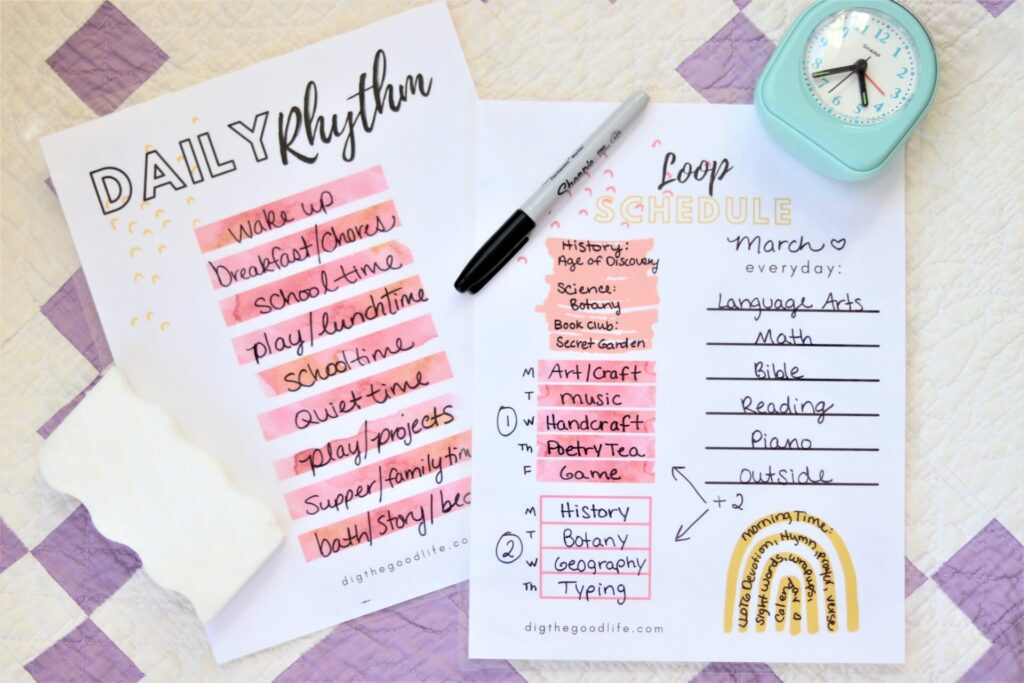Are you looking to add more flexibility and structure to your homeschooling routine? If you’ve heard about the loop schedule but aren’t quite sure what it entails, you’re in the right place. In this blog, we will delve into the concept of the loop schedule in homeschooling and provide you with all the essential information you need to understand and implement it effectively.
The loop schedule in homeschooling is a dynamic approach that offers a unique way to organize and prioritize your educational activities. Whether you’re a seasoned homeschooler or just starting out on your homeschooling journey, incorporating the loop schedule can bring a breath of fresh air to your learning environment.
Understanding the Loop Schedule in Homeschooling
As a homeschooling parent, grasping the concept of the loop schedule is crucial for an effective teaching routine. The loop schedule is a flexible approach that allows you to rotate through various subjects or activities without the constraints of a rigid timetable. It provides the freedom to prioritize certain topics based on your child’s interests or needs while ensuring a well-rounded education.
Benefits of Using a Loop Schedule
Embracing the loop schedule in homeschooling offers numerous advantages. Flexibility is one of the key benefits as it allows you to adapt your daily routine based on your child’s learning pace. Moreover, the loop schedule promotes variety by incorporating diverse subjects and activities, making learning engaging and stimulating for your child.
Implementing a Loop Schedule
Creating a loop schedule involves organizing your subjects or tasks in a sequential manner that can be easily rotated. Start by listing all the topics you want to cover and prioritize them based on importance or your child’s interests. Utilize tools like bullet journals or digital planners to keep track of your loop schedule effectively.
Remember, consistency is key when implementing a loop schedule. Ensure you allocate an appropriate amount of time to each subject or activity to maintain a balanced routine. Additionally, involve your child in the process to foster ownership and responsibility for their learning journey.

Benefits of Implementing a Loop Schedule
Implementing a loop schedule in homeschooling can offer numerous advantages that cater to both the students and the overall structure of the learning environment. Let’s delve into some of the key benefits:
1. Enhanced Flexibility
One of the primary benefits of a loop schedule is the flexibility it provides in tailoring the learning experience to individual student needs. This allows for a more personalized approach to education, accommodating varying learning paces and styles.
2. Optimized Learning Progression
By using a loop schedule, students can revisit topics or subjects at appropriate intervals, reinforcing knowledge retention and promoting a deeper understanding. This cyclical approach ensures that essential concepts are not forgotten over time.
3. Reduced Pressure
The loop schedule can help alleviate the pressure often associated with strict, linear curriculums. Students have the freedom to learn at their own pace without the fear of falling behind or being rushed through material, fostering a more relaxed and conducive learning environment.

How to Create a Loop Schedule for Homeschooling
Creating a loop schedule for homeschooling can be an efficient way to ensure that students cover all necessary subjects while maintaining flexibility. To start, identify the subjects you want to include in the loop schedule. These can range from core subjects like Math and English to extracurriculars like Art and Music.
Setting Priorities
Begin by prioritizing the subjects based on their importance and your child’s interest. Give more time to challenging subjects or those that require daily practice. Consistency is key in setting priorities.
Creating a Rotating Schedule
Once you have your list of subjects, create a rotating schedule where each subject is allotted a specific time slot. For example, Math may be scheduled for Mondays and Wednesdays, while Science is on Tuesdays and Thursdays.
Consider using a bullet journal or a digital planner to keep track of the schedule. This way, you can easily make adjustments as needed.
Tips for Successful Implementation of the Loop Schedule
Implementing a loop schedule in homeschooling can be a game-changer for both parents and students. To ensure success, consider the following tips:
Consolidate Topics Effectively
When planning your loop schedule, what is important is to consolidate subjects effectively. Group similar topics together to create a cohesive learning experience.
By consolidating topics, you can create a more engaging and focused academic environment for your child.
Utilize Visual Aids
Visual aids play a crucial role in enhancing the learning process. Incorporate diagrams, charts, and educational videos to make complex concepts easier to understand.
- Use educational apps to supplement traditional teaching methods.
- Encourage hands-on learning through experiments and interactive activities.

Examples of Loop Schedules for Different Subjects
Creating a loop schedule in homeschooling can provide a flexible structure for covering various subjects effectively. Here are examples of loop schedules for different subjects to give you an idea of how to organize your homeschooling curriculum:
Mathematics
Integrating math into your loop schedule can be achieved by rotating through topics such as arithmetic, geometry, algebra, and statistics. For instance, you can dedicate one day to each topic and rotate through them in your loop, ensuring comprehensive coverage over time.
Science
Science subjects like biology, chemistry, physics, and Earth science can be included in the loop schedule by alternating between them on a weekly or bi-weekly basis. This approach allows for a well-rounded science education throughout the academic year.
Language Arts
Language arts encompassing reading, writing, grammar, and literature can be cycled through in the loop schedule by focusing on different aspects each day or week. This ensures that your child receives a balanced language arts education.
History & Social Studies
History and social studies topics can be explored in the loop schedule by delving into different time periods, civilizations, and geographical regions. By rotating through these subjects, students can develop a comprehensive understanding of the world around them.
Frequently Asked Questions
- What is a loop schedule in homeschooling?
- A loop schedule in homeschooling is a flexible approach where subjects or activities are rotated through in a looping pattern instead of following a fixed daily schedule.
- How does a loop schedule work in homeschooling?
- With a loop schedule, instead of assigning specific subjects to each day of the week, homeschoolers rotate through a list of subjects or activities, completing them in order until all have been covered before starting the loop again.
- What are the benefits of using a loop schedule in homeschooling?
- Some benefits of using a loop schedule in homeschooling include flexibility, the ability to focus on individual progress rather than keeping up with a rigid schedule, and the chance to cater to each child’s strengths and interests.
- How can I create a loop schedule for homeschooling?
- To create a loop schedule for homeschooling, you can start by listing all the subjects or activities you want to cover, prioritizing them based on importance or frequency, and then rotating through them in a way that works best for your family’s routine and preferences.
- Is a loop schedule suitable for all homeschooling families?
- While a loop schedule can work well for many homeschooling families, it may not be the best fit for everyone. It is important to consider your family’s dynamics, your children’s learning styles, and your overall homeschooling goals before deciding if a loop schedule is right for you.
Unlocking the Magic of Loop Schedule Homeschooling
In conclusion, understanding what the loop schedule is in homeschooling can revolutionize your approach to teaching and learning. By incorporating this flexible and personalized method into your routine, you can create a dynamic and engaging educational experience for your children.
Remember, the loop schedule offers the freedom to explore subjects at your own pace, cater to each child’s unique learning style, and prioritize meaningful topics. It promotes consistency without the rigidity of a fixed timetable, fostering a love for learning and empowering students to take ownership of their education.
So, whether you’re a seasoned homeschooling parent or considering this educational path for the first time, embracing the loop schedule can truly enhance your homeschooling journey. Here’s to fostering curiosity, nurturing creativity, and embracing the joy of learning through the magic of loop scheduling!
